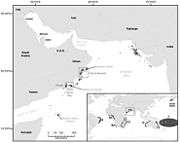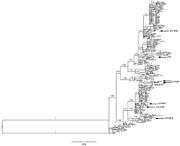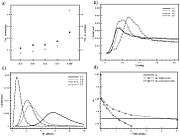Humpback whale
The humpback whale (Megaptera novaeangliae) is a species of baleen whale. It is one of the larger rorqual species, with adults ranging in length from 12–16 m (39–52 ft) and weighing around 25–30 metric tons (28–33 short tons). The humpback has a distinctive body shape, with long pectoral fins and a knobbly head. It is known for breaching and other distinctive surface behaviors, making it popular with whale watchers. Males produce a complex song lasting 10 to 20 minutes, which they repeat for hours at a time. All the males in a group will produce the same song, which is different each season. Its purpose is not clear, though it may help induce estrus in females.[4]
| Humpback whale[1] | |
|---|---|
 | |
.svg.png) | |
| Size compared to an average human | |
| Scientific classification | |
| Kingdom: | Animalia |
| Phylum: | Chordata |
| Class: | Mammalia |
| Order: | Artiodactyla |
| Infraorder: | Cetacea |
| Family: | Balaenopteridae |
| Genus: | Megaptera Gray, 1846 |
| Species: | M. novaeangliae |
| Binomial name | |
| Megaptera novaeangliae Borowski, 1781 | |
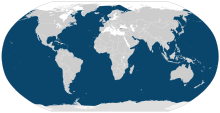 | |
| Humpback whale range | |
| Synonyms | |
| |
Found in oceans and seas around the world, humpback whales typically migrate up to 25,000 km (16,000 mi) each year. They feed in polar waters, and migrate to tropical or subtropical waters to breed and give birth, fasting and living off their fat reserves. Their diet consists mostly of krill and small fish. Humpbacks have a diverse repertoire of feeding methods, including the bubble net technique.
Like other large whales, the humpback was a target for the whaling industry. The species was once hunted to the brink of extinction; its population fell by an estimated 90% before a 1966 moratorium. While stocks have partially recovered to some 80,000 animals worldwide, entanglement in fishing gear, collisions with ships and noise pollution continue to affect the species.
Taxonomy
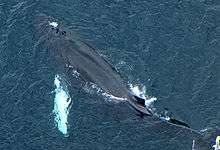
| ||||||||||||||||||||||||||||||||||||||||||||||||
| A phylogenetic tree of animals related to the humpback whale |
Humpback whales are rorquals, members of the Balaenopteridae family that includes the blue, fin, Bryde's, sei and minke whales. The rorquals are believed to have diverged from the other families of the suborder Mysticeti as long ago as the middle Miocene era.[5] However, it is not known when the members of these families diverged from each other.
Though clearly related to the giant whales of the genus Balaenoptera, the humpback is the sole member of its genus. Recent DNA sequencing has indicated the humpback is actually more closely related to certain rorquals, particularly the fin whale (B. physalus) and possibly the gray (Eschrichtius robustus), than it is to others such as the minke.[6][7][8][9]
The humpback was first identified as baleine de la Nouvelle Angleterre by Mathurin Jacques Brisson in his Regnum Animale of 1756. In 1781, Georg Heinrich Borowski described the species, converting Brisson's name to its Latin equivalent, Balaena novaeangliae. In 1804, Lacépède shifted the humpback from the family Balaenidae, renaming it B. jubartes. In 1846, John Edward Gray created the genus Megaptera, classifying the humpback as Megaptera longipinna, but in 1932, Remington Kellogg reverted the species names to use Borowski's novaeangliae.[10] The common name is derived from the curving of their backs when diving. The generic name Megaptera from the Ancient Greek mega- μεγα ("giant") and ptera/ πτερα ("wing"),[11] refers to their large front flippers. The specific name means "New Englander" and was probably given by Brisson due to regular sightings of humpbacks off the coast of New England.[10]
Genetic research in mid-2014 by the British Antarctic Survey confirmed that the separate populations in the North Atlantic, North Pacific and Southern Oceans are more distinct than previously thought. Some biologists believe that these should be regarded as separate subspecies[12] and that they are evolving independently.[13]
Anatomy
Humpbacks can easily be identified by their stocky body, obvious hump, black dorsal coloring and elongated pectoral fins. The head and lower jaw are covered with knobs called tubercles, which are hair follicles and are characteristic of the species. The fluked tail, which typically rises above the surface when diving, has wavy trailing edges.[14]
Humpbacks have 270 to 400 darkly colored baleen plates on each side of their mouths.[15] The plates measure from 18 in (46 cm) in the front to about 3 ft (0.91 m) in the back, behind the hinge.
Ventral grooves run from the lower jaw to the umbilicus, about halfway along the underside of the body. These grooves are less numerous (usually 14–22) than in other rorquals, but are fairly wide.[15]
The female has a hemispherical lobe about 15 cm (5.9 in) in diameter in her genital region. This visually distinguishes males and females.[15] The male's penis usually remains hidden in the genital slit.[16]
Size
Fully grown males average 13–14 m (43–46 ft). Females are slightly larger at 15–16 m (49–52 ft); one large recorded specimen was 19 m (62 ft) long and had pectoral fins measuring 6 m (20 ft) each.[17] The largest humpback on record, according to whaling records, was a female killed in the Caribbean; she was 27 m (89 ft) long with a weight of 90 metric tons (99 short tons), although the reliability of these extremely atypical data is impossible to confirm.[18] The largest measured by the scientists of the Discovery Committee were a female and a male at 14.9 and 14.75 m (48.9 and 48.4 ft) respectively, although this was out of a sample size of only 63 whales.[19] Body mass typically is in the range of 25–30 metric tons (28–33 short tons), with large specimens weighing over 40 metric tons (44 short tons).[20]
Fins
The long black and white tail fin can be up to a third of body length.[21][22]
Several hypotheses attempt to explain the humpback's pectoral fins, which are proportionally the longest fins of any cetacean. The higher maneuverability afforded by long fins and the usefulness of the increased surface area for temperature control when migrating between warm and cold climates may have supported this adaptation. These very long heavy pectoral fins with a row of knuckle-like knobs along their anterior edges are effective weapons in confrontations with killer whales.[23] Humpbacks frequently defend other animals against attack by predators; for example, they were observed interfering to defend a grey whale calf that had just been killed by killer whales.[23] The large sharp-cornered barnacle Coronula diadema often attaches there, adding a natural equivalent of knuckledusters.[24]
Identifying individuals
The varying patterns on the tail flukes distinguish individual animals. Identification is done by comparing the amount of white vs black and scars on the fluke. The humpback whales are then given a catalogue number. A study using data from 1973 to 1998 on whales in the North Atlantic gave researchers detailed information on gestation times, growth rates and calving periods, as well as allowing more accurate population predictions by simulating the mark-release-recapture technique.[25] A photographic catalogue of all known North Atlantic whales was developed over this period and is maintained by College of the Atlantic.[26] Similar photographic identification projects operate around the world.
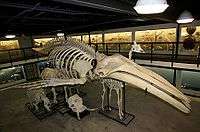 Humpback whale skeleton on display at The Museum of Osteology, Oklahoma City, Oklahoma
Humpback whale skeleton on display at The Museum of Osteology, Oklahoma City, Oklahoma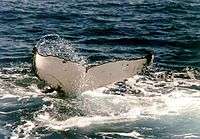 A humpback whale tail displaying wavy rear edges
A humpback whale tail displaying wavy rear edges.jpg) A tail from a different individual—the tail of each humpback whale is visibly unique.
A tail from a different individual—the tail of each humpback whale is visibly unique.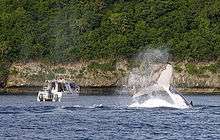
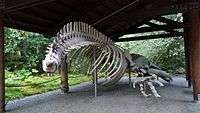 Humpback whale skeleton of "Snow" on display at Glacier Bay National Park and Preserve
Humpback whale skeleton of "Snow" on display at Glacier Bay National Park and Preserve
Behavior
The lifespan of rorquals ranges from 45 to 100 years.[27]
Interactions
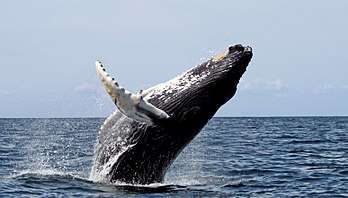
Courtship and reproduction
Courtship rituals take place during the winter months, following migration toward the equator from summer feeding grounds closer to the poles. Competition is usually fierce. Unrelated males, dubbed escorts, frequently trail females, as well as cow-calf pairs. Males gather into competitive groups around a female and fight for the right to mate with her.[28] Group size ebbs and flows as unsuccessful males retreat and others arrive. Behaviors include breaching, spyhopping, lob-tailing, tail-slapping, pectoral fin-slapping, peduncle throws, charging and parrying.
Whale song is thought to have an important role in inducing estrus in females[4] and in mate selection; however, it may also be used between males to establish dominance.[29] Humpback whales are polyandrous, with a female having multiple male partners over the course of her lifespan.[30]

Females typically breed every two or three years. The gestation period is 11.5 months. The peak months for birth are January and February in the Northern Hemisphere, July and August in the Southern Hemisphere. Females wait for one to two years before breeding again. Recent research on mitochondrial DNA reveals that groups living in proximity to each other may represent distinct breeding pools.[31] Humpback whale births have been rarely observed. One birth witnessed off Madagascar occurred within four minutes.[32] Humpback whales have been known to hybridize with other rorquals; there is a well-documented report of a humpback-blue whale hybrid in the South Pacific.[33]
Interspecies interactions
Humpbacks are a friendly species that interact with other cetaceans such as bottlenose dolphins. Right whales interact with humpbacks.[34] These behaviors have been recorded in all oceans.[35][36] Records of humpback and southern right whales demonstrating what were interpreted to be mating behaviors have been documented off the Mozambique [37] and Brazilian coasts.[38] Humpback whales appear in mixed groups with other species, such as the blue, fin, minke, gray and sperm whales.[39] Interaction with gray, fin,[40] and right whales have been observed. Teams of researchers observed a male humpback whale singing an unknown type of song and approaching a fin whale at Rarotonga in 2014.[41] One individual was observed playing with a bottlenose dolphin in Hawaiian waters.[42] Incidents of humpback whales protecting other animals such as seals and other whales from killer whales have been documented and filmed. Studies of such incidents indicate that the phenomenon is species-wide and global, with incidents being recorded at various locations across the world.[43] In September 2017 in Rarotonga, the Cook Islands, snorkeler and whale biologist Nan Hauser reported that two adult humpback whales had protected her from a 4.5 m (15 ft) tiger shark, with one whale pushing her away from the shark while the other used its tail to block the shark's advances.[44]
Song

Both male and female humpback whales vocalize, but only males produce the long, loud, complex "song" for which the species is famous. Each song consists of several sounds in a low register, varying in amplitude and frequency and typically lasting from 10 to 20 minutes.[45] Individuals may sing continuously for more than 24 hours. Cetaceans have no vocal cords, instead, they produce sound via a larynx-like structure found in the throat, the mechanism of which has not been clearly identified. Whales do not have to exhale to produce sound.[46]
Whales within a large area sing a single song. All North Atlantic humpbacks sing the same song, while those of the North Pacific sing a different song. Each population's song changes slowly over a period of years without repeating.[45]
Scientists are unsure of the purpose of whale songs. Only males sing, suggesting one purpose is to attract females or to induce estrus in the females.[4] However, many of the whales observed to approach a singer are other males, often resulting in conflict. Singing may, therefore, be a challenge to other males.[47] Some scientists have hypothesized the song may serve an echolocative function.[48] During the feeding season, humpbacks make unrelated vocalizations for herding fish into their bubble nets.[49]
Humpback whales make other sounds to communicate, such as grunts, groans, snorts and barks.[50]
Breathing
Whales are air-breathing mammals who must surface to get the air they need. The stubby dorsal fin is visible soon after the blow (exhalation) when the whale surfaces, but disappears by the time the flukes emerge. Humpbacks have a 3 m (9.8 ft), heart-shaped bushy blow through the blowholes. They do not generally sleep at the surface, but they must continue to breathe. Possibly only half of their brain sleeps at one time, with one half managing the surface-blow-dive process without awakening the other half.[51]
Range and habitat

Humpbacks inhabit all major oceans, in a wide band running from the Antarctic ice edge to 81°N[55] latitude. The four global populations are North Pacific, Atlantic, Southern Ocean and Indian Ocean populations. These populations are distinct. Although the species has cosmopolitan distribution and is usually not considered to cross the equator line, seasonal observations at Cape Verde suggest possible interactions among populations from both hemispheres.[56] Aside from the Arabian Sea group, year-round presences have been confirmed among British and Norwegian waters.[57] Parts of wintering grounds around the globe have been poorly studied or being undetected, such as around Pitcairn Islands,[58] Northern Mariana Islands (e.g. Marpi[59] and CK Reefs vicinity to Saipan),[60] Volcano Islands,[61] Pasaleng Bay, Trindade and Martin Vaz, Mauritius, and Aldabra.[62]
Whales were once uncommon in the Mediterranean and the Baltic Seas, but have increased their presence in both waters as global populations have recovered. Recent increases within the Mediterranean basin, including re-sightings, indicate that more whales may migrate into the inland sea in the future, not only for wintering but also for feeding.[63][64] Humpbacks are also showing signs of re-expanding into former ranges, such as Scotland,[57] Skagerrak and Kattegat,[65] as well as Scandinavian fjords such as Kvænangen, where they had not been observed for decades.[66][67]
In the North Atlantic, feeding areas range from Scandinavia to New England. Breeding occurs in the Caribbean and Cape Verde.[68] In the South Atlantic and Indian Oceans, whales may breed off Brazil, as well the coasts of central, southern and southeastern Africa (including Madagascar).[69] Whale visits into Gulf of Mexico have been infrequent, but occurred in the gulf historically.[70] In the South Atlantic, about 10% of world population of the species possibly migrate to the Gulf of Guinea. Comparison of songs between those at Cape Lopez and Abrolhos Archipelago indicate that trans-Atlantic mixings between western and southeastern populations occur.[71]
A large population spreads across the Hawaiian Islands every winter, ranging from the island of Hawaii in the south to Kure Atoll in the north.[72] These animals feed in areas ranging from the coast of California to the Bering Sea.[73] Humpbacks were first observed in Hawaiian waters in the mid-19th century and might have gained a dominance over North Pacific right whales, as the right whales were hunted to near-extinction.[74]
A 2007 study identified seven individuals then wintering off the Pacific coast of Costa Rica as having traveled from the Antarctic—around 8,300 km (5,200 mi). Identified by their unique tail patterns, these animals made the longest documented mammalian migration.[75] In Australia, two main migratory populations were identified, off the west and east coasts. These two populations are distinct, with only a few females in each generation crossing between the two groups.[76]
In Panama and Costa Rica, humpback whales come from both the Southern Hemisphere (July–October with over 2,000 whales) and the Northern Hemisphere (December–March numbering about 300).[77] South Pacific populations migrating off mainland New Zealand, Kermadec Islands, and Tasmania are increasing, but less rapidly than in Australian waters because of illegal whaling by the Soviet Union in the 1970s.
Some recolonizing habitats are confirmed, especially in the North and South Atlantic (e.g. English and Irish coasts, English Channel)[78] to coasts in the north such as the North Sea and Wadden Sea, where the first confirmed sighting since 1755 was made in 2003,[79][80] South Pacific (e.g. New Zealand coasts and Niue), pelagic islands of Chile such as Isla Salas y Gómez and Easter Island, where possibilities of undocumented wintering grounds have been considered,[81] southern fiords of Chile and Peru (e.g. Gulf of Penas, Strait of Magellan, Beagle Channel)[82] and in Asia, such as in the Philippines, Babuyan Islands, Cagayan (the first modern mortality of the species in the nation was in 2007),[83] Calayan[84] and Pasaleng Bay, the Ryukyu Islands, the Volcano Islands in Japan, the Northern Mariana Islands recently[85] again became stable/growing wintering grounds while the Marshall Islands,[86] Vietnamese, Taiwanese and Chinese coasts show slow or no obvious recovery.[87] In 2020, A whale has been spotted wandering at Saint Lawrence River in Montreal[88] and a Migaloo in Australian waters.[89]
In Asia

Whales again migrate off Japanese archipelagos and into the Sea of Japan. Connections between these stocks and whales seen in the Sea of Okhotsk, on Kamchatka coasts and around the Commander Islands have been studied.[90] Historical wintering distributions could have been much wider and more southerly distributed, as whales were seen in areas along the Batanes, Sulu and Celebes Seas including off Palawan, Luzon, Malaysia and Mindanao, with higher densities around today's Cape Eluanbi and Kenting National Park.[91] Unconfirmed sightings have been reported near Borneo in modern times.[92] The first confirmation in modern Taiwan was of a pair off Hualien in 1994, followed by a successful escape from entanglement off Taitung in 1999,[93] and continuous sightings around Orchid Island in 2000.[94] Few/none regularly migrate into Kenting National Park.[95][96] In addition, despite sightings reported almost annually off Green and Orchid Islands, relatively short stays in these waters indicate recoveries as winter foraging has not occurred.[97] Sightings, including of a cow-calf pair, have occurred along the east coast of Taiwan.[98][99][100][101] Around Hong Kong, two documented sightings were recorded in 2009 and in 2016.[102][103] One of the first documented sightings within the Yellow Sea was of a group of 3 or 4 individuals, including a cow/calf pair in Changhai County in October, 2015.[104][105]
Since November 2015, whales gather around Hachijō-jima, far north from the known breeding areas in the Bonin Islands. All breeding activities except for giving births had been confirmed as of January, 2016. That makes Hachijo-jima the northernmost breeding ground in the world,[106] north of breeding grounds such as Amami Ōshima, Midway Island,[107] and Bermuda.[108]
Arabian Sea
A non-migratory population in the Arabian Sea remains there year-round.[45] More typical annual migrations cover up to 25,000 km (16,000 mi), making it one of the most-traveled mammalian species. Genetic studies and visual surveys indicate that the Arabian group is the most isolated of all humpback groups and is the most endangered, numbering possibly fewer than 100 animals.[109] Within the Arabian Sea, Masirah Island and Gulf of Masirah, Halaniyat Islands and Kuria Muria Bay are hot spots for the species.[110]
Whales were historically common in continental and marginal waters such as the Hallaniyat Islands,[111] along Indian coasts, Persian Gulf[112] and Gulf of Aden, and recent migrations into the gulf including by cow-calf pairs. It is unknown whether whales seen in the Red Sea originate in this population,[115] however sightings increased since in 2006 even in the northern part of the sea such as in Gulf of Aqaba. Individuals may reach the Maldives, Sri Lanka, or further east.[109] Humpbacks have been considered rather vagrant into Persian Gulf, however new studies indicate more regular presences can be expected.[110]
Origins of whales occurring at Maldives are not clear either from Arabian or south Pacific populations, and overlaps are possible.[116][109]
Feeding and predators
Humpbacks feed primarily in summer and live off fat reserves during winter.[117] They feed only rarely and opportunistically in their wintering waters. The humpback is an energetic hunter, taking krill and small schooling fish such as juvenile Atlantic and Pacific salmon, herring, capelin and American sand lance, as well as Atlantic mackerel, pollock, haddock and Atlantic menhaden in the North Atlantic.[118][119][120][121] They have been documented opportunistically feeding near fish hatcheries in Southeast Alaska, feasting on salmon fry released from the hatcheries.[122] Krill and copepods are prey species in Australian and Antarctic waters.[123] Humpbacks hunt by direct attack or by stunning prey by hitting the water with pectoral fins or flukes.
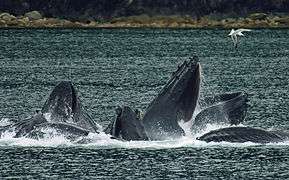 A group of 15 whales bubble net fishing near Juneau, Alaska
A group of 15 whales bubble net fishing near Juneau, Alaska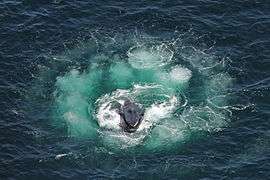 Whale lunging in the center of a bubble net spiral
Whale lunging in the center of a bubble net spiral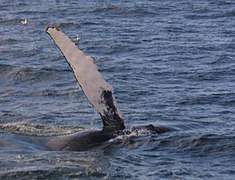 Slapping pectoral fins
Slapping pectoral fins A whale off Australia on the spring migration, feeding on krill by turning on its side and propelling through the krill
A whale off Australia on the spring migration, feeding on krill by turning on its side and propelling through the krill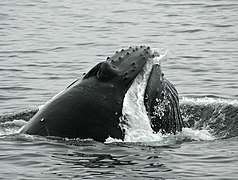 A humpback straining water through its baleen after lunging
A humpback straining water through its baleen after lunging
Bubble net
The humpback has the most diverse hunting repertoire of all baleen whales.[124] Its most inventive technique is known as bubble net feeding; a group of whales swims in a shrinking circle blowing bubbles below a school of prey. The shrinking ring of bubbles encircles the school and confines it in an ever-smaller cylinder. This ring can begin near 30 m (98 ft) in diameter and involve the cooperation of a dozen animals. Using a crittercam attached to a whale's back, researchers found that some whales blow the bubbles, some dive deeper to drive fish toward the surface and others herd prey into the net by vocalizing.[125] The whales then suddenly swim upward through the "net", mouths agape, swallowing thousands of fish in one gulp. The water is then squeezed out through baleen plates in the mouth to filter out the prey.
So-called lobtail feeding was observed in the North Atlantic. This technique involves the whale slapping the surface of the ocean with its tail between one and four times before creating the bubble net.[126] Using network-based diffusion analysis, the study authors argued that these whales learned the behavior from other whales in the group over a period of 27 years in response to a change in the primary form of prey.[127]
Killer whale and shark predation
Visible scars indicate that killer whales (orcas) can prey upon juvenile humpbacks, though until recently hunting had never been witnessed and attacks were assumed to be superficial in nature.[128] However, a 2014 study off Western Australia[129] observed that when available in large numbers, young humpbacks can be attacked and sometimes killed by orcas. Moreover, mothers and (possibly related) adults escort neonates to deter such predation. The suggestion is that when humpbacks suffered near-extinction during the whaling era, orcas turned to other prey, but are now resuming their former practice. There is also evidence that humpback whales will defend against or attack killer whales who are attacking either humpback calves or juveniles as well as members of other species.[24] The great white shark is another confirmed predator of the humpback whale. In 2020, Marine biologists Dines and Gennari et al., published a documented incident they had recorded in 2019 in the journal "Marine and Freshwater Research" of a group of great white sharks exhibiting pack-like behavior to successfully attack and kill a live adult humpback whale. The sharks utilized the classic attack strategy they utilized on pinnipeds such as seals and sea lions when attacking the whale, even utilizing the bite-and-spit tactic they employ on said prey items. The incident is the first known documentation of great whites actively killing a large baleen whale and the first record known of a live humpback whale falling victim to this species of shark.[130] A second incident regarding great white sharks killing humpback whales was documented off the coast of South Africa. The shark recorded instigating the attack was a female nicknamed "Helen". Working alone, the shark attacked a 33 ft (10 m) emaciated and entangled humpback whale by attacking the whale's tail to cripple and bleed the whale before she managed to drown the whale by biting onto its head and pulling it underwater. The attack was witnessed via aerial drone by marine biologist Ryan Johnson, who said the attack went on for roughly 50 minutes before the shark successfully killed the whale. Johnson further suggested that the shark may have strategized its attack in order to kill such a large animal, and may have had previous experience in attacking such large cetaceans.[131][132]
Relation to humans
Whaling
Humpback whales were hunted as early as the 18th century. By the 19th century, many nations (particularly the United States) were hunting the animal heavily in the Atlantic Ocean and to a lesser extent in the Indian and Pacific Oceans. The late-19th-century introduction of the explosive harpoon allowed whalers to accelerate their take. This, along with hunting in the Antarctic Ocean beginning in 1904, sharply reduced whale populations. During the 20th century, over 200,000 humpbacks were taken, reducing the global population by over 90%. North Atlantic populations dropped to as low as 700 individuals.[133]
Ban
In 1946, the International Whaling Commission (IWC) was founded to oversee the industry. They imposed hunting regulations and created hunting seasons. To prevent extinction, IWC banned commercial humpback whaling in 1966. By then, the global population had been reduced to around 5,000.[134] The ban has remained in force since 1966.
Prior to commercial whaling, populations could have reached 125,000. North Pacific kills alone are estimated at 28,000.[14] The Soviet Union deliberately under-recorded its catches; the Soviets reported catching 2,820 between 1947 and 1972, but the true number was over 48,000.[135]
As of 2004, hunting was restricted to a few animals each year off the Caribbean island of Bequia in the nation of St. Vincent and the Grenadines.[124] The take is not believed to threaten the local population. Japan had planned to kill 50 humpbacks in the 2007/08 season under its JARPA II research program. The announcement sparked global protests.[136] After a visit to Tokyo by the IWC chair asking the Japanese for their co-operation in sorting out the differences between pro- and antiwhaling nations on the commission, the Japanese whaling fleet agreed to take no humpback whales during the two years it would take to reach a formal agreement.[137]
In 2010, the IWC authorized Greenland's native population to hunt a few humpback whales for the following three years.[138]
In Japan, humpback, minkes, sperm and many other smaller Odontoceti, including critically endangered species such as North Pacific right, western gray and northern fin, have been targets of illegal captures. The hunts use harpoons for dolphin hunts or intentionally drive whales into nets, reporting them as cases of entanglement. Humpback meat can be found in markets. In one case, humpbacks of unknown quantities were illegally hunted in the Exclusive Economic Zones of anti-whaling nations such as off Mexico and South Africa.[139]
Whale-watching
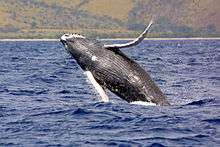
Whale watching is the leisure activity of observing humpbacks in the wild. Participants watch from shore or on touring boats. Humpbacks are generally curious about nearby objects. Some individuals, referred to as "friendlies", approach whale-watching boats closely, often staying under or near the boat for many minutes. Because humpbacks are typically easily approachable, curious, identifiable as individuals and display many behaviors, they have become the mainstay of whale tourism around the world. Hawaii has used the concept of "ecotourism" to benefit from the species without killing them. This business brings in revenue of $20 million per year for the state's economy.[140]
| North Atlantic | North Pacific | Southern Hemisphere | |
|---|---|---|---|
| Summer | New York, New England, Grand Manan Island, Nova Scotia and Newfoundland, the northern St. Lawrence River, the Snaefellsnes peninsula in the west of Iceland. | Bahía Solano and Nuquí in Colombia, California, Alaska, Oregon, Washington, British Columbia, Isla Iguana in Panama, Ecuador. | Antarctica. |
| Winter | Samaná Province of the Dominican Republic, the Bay of Biscay France, Mona Passage off the coast of Puerto Rico | Hawaii, Baja California Sur, the Bahía de Banderas off Puerto Vallarta, Ogasawara, Okinawa | Sydney, Byron Bay north of Sydney, Hervey Bay north of Brisbane, North and East of Cape Town, New Zealand especially Kaikoura, the Tongan islands, Victor Harbor and outlying beaches, Saint Helena in the South Atlantic. |
Notable individuals
The Tay whale

In December 1883, a male humpback swam up the Firth of Tay in Scotland, past what was then the whaling port of Dundee. Harpooned during a failed hunt, it was found dead off of Stonehaven a week later. Its carcass was exhibited to the public by a local entrepreneur, John Woods, both locally and then as a touring exhibition that traveled to Edinburgh and London. The whale was dissected by Professor John Struthers, who wrote seven papers on its anatomy and an 1889 monograph on the humpback.[141][142][143][144]
Migaloo
.jpg)
An albino humpback whale that travels up and down the east coast of Australia became famous in local media because of its rare, all-white appearance. Migaloo is the only known Australian all-white specimen[145] and is a true albino.[146] First sighted in 1991, the whale was named for an indigenous Australian word for "white fella". To prevent sightseers approaching dangerously close, the Queensland government decreed a 500-m (1600-ft) exclusion zone around him.[147]
Humphrey
In 1985, Humphrey swam into San Francisco Bay and then up the Sacramento River towards Rio Vista.[148] Five years later, Humphrey returned and became stuck on a mudflat in San Francisco Bay immediately north of Sierra Point below the view of onlookers from the upper floors of the Dakin Building. He was twice rescued by the Marine Mammal Center and other concerned groups in California.[149] He was pulled off the mudflat with a large cargo net and the help of the US Coast Guard. Both times, he was successfully guided back to the Pacific Ocean using a "sound net" in which people in a flotilla of boats made unpleasant noises behind the whale by banging on steel pipes, a Japanese fishing technique known as oikami. At the same time, the attractive sounds of humpback whales preparing to feed were broadcast from a boat headed towards the open ocean.[150] He was last sighted in the vicinity of the Farallon Islands in 1991.
Media
Analyses of whale songs in the 1960s led to worldwide media interest and convinced the public that whales were highly intelligent, aiding the antiwhaling advocates.
Status
Threats

While whaling no longer threatens the species, individuals are vulnerable to collisions with ships, entanglement in fishing gear and noise pollution.[151] Like other cetaceans, humpbacks can be injured by excessive noise. In the 19th century, two humpback whales were found dead near sites of repeated oceanic sub-bottom blasting, with traumatic injuries and fractures in the ears.[152]
Saxitoxin, a paralytic shellfish poisoning from contaminated mackerel, has been implicated in humpback whale deaths.[153]
Whale researchers along the Atlantic Coast report that there have been more stranded whales with signs of vessel strikes and fishing gear entanglement in recent years than ever before. The NOAA recorded 88 stranded humpback whales between January 2016 and February 2019. This is more than double the number of whales stranded between 2013 and 2016. Because of the increase in stranded whales NOAA declared an unusual mortality event in April 2017. This declaration still stands. Virginia Beach aquarium's stranding response coordinator, Alexander Costidis says the conclusions are that the two causes of these unusual mortality events are vessel interactions and entanglements.[154]
Conservation
The worldwide population is at least 80,000, with 18,000–20,000 in the North Pacific,[155] about 12,000 in the North Atlantic[156] and over 50,000 in the Southern Hemisphere,[157] down from a prewhaling population of 125,000.[14]
The NOAA is committed to protecting and recovering the humpback whale. NOAA enacted vessel speed restrictions which serve to protect the endangered North Atlantic right whale and many other species of whales. They respond to dead, injured, or entangled whales. They also educate whale watchers, tourists, and vessel operators on responsible viewing of the humpback whales. NOAA works to develop methods to reduce vessel strikes and reduce risk of entanglement in fishing gear. The NOAA's work will help reduce the number of humpback whale deaths.[158]
Least concern
In August 2008, the IUCN changed humpbacks' status from Vulnerable to Least Concern, although two subpopulations remain endangered.[159] The United States is considering listing separate humpback populations, so smaller groups, such as North Pacific humpbacks, which are estimated to number 18,000–20,000 animals, might be delisted. This is made difficult by humpbacks’ migrations, which can extend 5,157 miles (8,299 km) from Antarctica to Costa Rica.[31] In Costa Rica, the Ballena Marine National Park is designed for humpback protection.
Areas where population data is limited and the species may be at higher risk include the Arabian Sea, the western North Pacific Ocean, the west coast of Africa and parts of Oceania.[3]
The species was listed as vulnerable in 1996 and endangered as recently as 1988. Most monitored stocks have rebounded since the end of commercial whaling.[3][160] In the North Atlantic stocks are believed to be approaching prehunting levels. However, the species is considered endangered in some countries, including the United States.[161][162]
United States
A 2008 US Department of Commerce analysis (SPLASH) noted that the many challenges to determining the recovery status included the lack of accurate population estimates, the unexpected complexity of population structures and their migration. The report was based on data collected from 2004 to 2006. At the time, the North Pacific population was some 18,302.[163] The estimate is consistent with a moderate rate of recovery for a depleted population, although it was considered to be a "dramatic increase in abundance" from other post-1960s estimates. By comparison, Calambokidis et al. estimated 9,819,[164] covering 1991–1993. This represents a 4% annual increase in population from 1993 to 2006.[163] The sanctuary provided by US national parks, such as Glacier Bay National Park and Preserve and Cape Hatteras National Seashore, became major factors in population recovery.[165]
Canada
Off the west coast of Canada, the Gwaii Haanas National Marine Conservation Area Reserve covers 3,400 square kilometres (1,300 sq mi). It is "a primary feeding habitat" of the North Pacific population. Their critical habitat overlaps with tanker shipping routes between Canada and its eastern trade partners.[166] In 2005 the North Pacific population was listed as threatened under Canada's Species at Risk Act (SARA). On April 19, 2014 the Department of the Environment recommended an amendment to SARA to downgrade their status off the Pacific coast from "threatened" to "species of special concern".[167] According to Committee on the Status of Endangered Wildlife in Canada (COSEWIC), the North Pacific humpback population increased at about 4% annually from 1992 to 2008. Although socioeconomic costs and benefits were considered in their decision to upgrade their status, according to the University of British Columbia's Marine Mammal Research Consortium's research director, the decision was based on biology, not politics.[166]
See also
References
- Mead, J.G.; Brownell, R. L. Jr. (2005). "Order Cetacea". In Wilson, D.E.; Reeder, D.M (eds.). Mammal Species of the World: A Taxonomic and Geographic Reference (3rd ed.). Johns Hopkins University Press. pp. 723–743. ISBN 978-0-8018-8221-0. OCLC 62265494.
- "Fossilworks: Megaptera". Fossilworks. Retrieved 2018-04-08.
- Cooke, J.G. (2018). "Megaptera novaeangliae". IUCN Red List of Threatened Species. 2018: e.T13006A50362794. Retrieved 18 January 2020.
- "30 Animals That Made Us Smarter, Whale and wind turbine". BBC World Service. 22 July 2019. Retrieved 2019-07-24.
- Gingerich, P. D. (2004). "Whale Evolution" (PDF). McGraw-Hill Yearbook of Science & Technology. The McGraw Hill Companies.
- Arnason, U.; Gullberg A. & Widegren, B. (September 1, 1993). "Cetacean mitochondrial DNA control region: sequences of all extant baleen whales and two sperm whale species". Molecular Biology and Evolution. 10 (5): 960–970. doi:10.1093/oxfordjournals.molbev.a040061. PMID 8412655. Retrieved 2009-01-25.
- Sasaki, T.; et al. (March 4, 2011). "Mitochondrial Phylogenetics and Evolution of Mysticete Whales". Systematic Biology. 54 (1): 77–90. doi:10.1080/10635150590905939. PMID 15805012. Retrieved 2011-06-06.
- Hatch, L.T.; Dopman, E.B. & Harrison, R.G. (May 26, 2006). "Phylogenetic relationships among the baleen whales based on maternally and paternally inherited characters" (PDF). Molecular Phylogenetics and Evolution. 41 (1): 12–27. doi:10.1016/j.ympev.2006.05.023. PMID 16843014.
- Seeman, Mette E.; et al. (December 2009). "Radiation of Extant Cetaceans Driven by Restructuring of the Ocean". Systematic Biology. 58 (6): 573–585. doi:10.1093/sysbio/syp060. JSTOR 25677547. PMC 2777972. PMID 20525610.
- Martin, Stephen (2001). The Whales' Journey. Allen & Unwin. p. 251. ISBN 978-1-86508-232-5.
- Liddell, Henry George; Scott, Robert (2 February 2015). Liddell and Scott's Greek-English Lexicon, Abridged. Martino Fine Books. ISBN 978-1-61427-770-5.
- "Humpback whale subspecies revealed by genetic study". Science Daily. May 20, 2014. Retrieved May 20, 2014.
- Ghose, Tina (May 22, 2014). "Oceans Apart: 3 Humpback Whale Subspecies Identified". Discovery News. Retrieved May 22, 2014.
- Final Recovery Plan for the Humpback Whale (Megapten Novaeangliae) (PDF). National Oceanic and Atmospheric Administration. 1991. Archived from the original (PDF) on 2011-06-13. Retrieved 2011-06-30.
- Clapham, Phillip J.; Mead, James G. (1999). "Megaptera novaeangliae" (PDF). Mammalian Species. 604 (604): 1–9. doi:10.2307/3504352. JSTOR 3504352.
- Pack, A.; et al. (2002). "Penis extrusions by humpback whales (Megaptera novaengliae)" (PDF). Aquatic Mammals. 28 (2): 131–146.
- Clapham 2002, pp. 589–592.
- Vallarta Adventures. Whale Watching Guide Archived 2014-08-13 at the Wayback Machine. Retrieved on November 7, 2014
- Mackintosh, N. A. (1943). "The southern stocks of whalebone whales". Discovery Reports. XXII (3889): 199–300. Bibcode:1944Natur.153..569F. doi:10.1038/153569a0.
- Burnie, David; Wilson, Don E. (2001). Animal: The Definitive Visual Guide to the World's Wildlife. DK. ISBN 978-0-7894-7764-4.
- Katona S.K.; Whitehead, H.P. (1981). "Identifying humpback whales using their mural markings". Polar Record. 20 (128): 439–444. doi:10.1017/s003224740000365x.
- Kaufman G.; Smultea M.A.; Forestell P. (1987). "Use of lateral body pigmentation patterns for photo ID of east Australian (Area V) humpback whales". Cetus. 7 (1): 5–13.
- television program Humpback Whales, a Detective Story, BBCTV2, 7 to 8 pm, Tuesday 16 July 2018
- Pitman, Robert L. (2016). "Humpback whales interfering when mammal-eating killer whales attack other species: Mobbing behavior and interspecific altruism?". Marine Mammal Science. 33: 7–58. doi:10.1111/mms.12343.
- Katona and Beard 1982
- Williamson, J. M. (2005). "Whalenet Data Search". Wheelock College. Retrieved 2007-04-03.
- Dawes & Campbell 2008, p. 291.
- Clapham, Phillip J. (26 February 2009). "Humpback Whale Megaptera novaeangliae". In Perrin, William F.; Wursig, Bernd; Thewissen, J.G.M. 'Hans' (eds.). Encyclopedia of Marine Mammals. Academic Press. pp. 582–84. ISBN 978-0-08-091993-5.CS1 maint: ref=harv (link)
- Darling, J.; et al. (2006). "Humpback whale songs: Do they organize males during the breeding season?" (PDF). Behaviour. 143 (9): 1051–1101. doi:10.1163/156853906778607381. Archived from the original (PDF) on 2008-08-21.
- Clapham, Phillip J.; Palsbøll, Per J. (1997-01-22). "Molecular analysis of paternity shows promiscuous mating in female humpback whales ( Megaptera novaeangliae, Borowski)". Proceedings of the Royal Society of London. Series B: Biological Sciences. 264 (1378): 95–98. Bibcode:1997RSPSB.264...95C. doi:10.1098/rspb.1997.0014. ISSN 0962-8452. PMC 1688232. PMID 9061965.
- Hotz, Robert Lee (November 6, 2009). "Whale Watch: Endangered Designation In Danger". The Wall Street Journal. Retrieved November 8, 2009.
- Faria, Maria-Alejandra (2013-09-01). "Short Note: Observation of a Humpback Whale (Megaptera novaeangliae) Birth in the Coastal Waters of Sainte Marie Island, Madagascar". Aquatic Mammals. 39 (3): 296–305. doi:10.1578/am.39.3.2013.296. ISSN 0167-5427.
- Reeves, Randall R.; Stewart, Brent S.; Clapham, Phillip J.; Powell, James A. National Audubon Society Guide to Marine Mammals of the World (1st ed.).
- Center for Coastal Studies, Right Whale Research, Field Notes, May 2007 Archived 2012-07-25 at the Wayback Machine
- "Rare Sighting of a North Pacific Right Whale (Eubalaena glacialis) in Hawai'i" (PDF).
- Center for Coastal Studies. 2007. Center for Coastal Studies / Right Whale Research / Field Notes / 2007 / May 2007 Archived 2012-07-25 at the Wayback Machine Retrieved on December 05. 2015
- Banks, A.; Best, P.; Gullan, A.; Guissamulo, A.; Cockcroft, V.; Findlay, K. Recent Sightings of Southern Right Whales in Mozambique (PDF) (Report). Retrieved 5 December 2015.
- "Instituto Baleia Jubarte". www.baleiajubarte.org.br.
- Shiretoko Nature Cruise. "平成20年6月30日 羅臼沖にめずらしいお客さま!". Archived from the original on 12 May 2014. Retrieved 13 May 2014.
- Joseph R Mobley (1 January 1996). "Fin Whale Sighting North of Kaua'i, Hawai'i". ResearchGate.
- Horton, Travis (2014-08-12). "Humpback Whale Migration – Rarotonga, 2014".
- Deakos, Mark H.; et al. (2010). "Two Unusual Interactions Between a Bottlenose Dolphin (Tursiops truncatus) and a Humpback Whale (Megaptera novaeangliae) in Hawaiian Waters". Aquatic Mammals. 36 (2): 121–28. doi:10.1578/AM.36.2.2010.121.
- "Humpback whales around the globe are mysteriously rescuing animals from orcas".
- Carbone, Christopher (8 January 2018). "Hero whale saves snorkeler from tiger shark in the Pacific Ocean". Fox News. Retrieved 24 July 2019.
- "American Cetacean Society Fact Sheet". American Cetacean Society. Retrieved 2007-04-17.
- Reidenberg, JS; Laitman, JT (2007). "Discovery of a low frequency sound source in Mysticeti (baleen whales): anatomical establishment of a vocal fold homolog". Anatomical Record. 290 (6): 745–59. doi:10.1002/ar.20544. PMID 17516447.
- "Humpback Whales. Song of the Sea". Public Broadcasting Station. Retrieved 2007-04-22.
- Mercado E 3rd, Frazer LN (July 2001). "Humpback Whale Song or Humpback Whale Sonar? A Reply to Au et al" (PDF). IEEE Journal of Oceanic Engineering. 26 (3): 406–415. Bibcode:2001IJOE...26..406M. CiteSeerX 10.1.1.330.3653. doi:10.1109/48.946514. Archived from the original (PDF) on 14 June 2007. Retrieved 3 April 2007.
- Mercado E 3rd, Herman LM, Pack AA (2003). "Stereotypical sound patterns in humpback whale songs: Usage and function" (PDF). Aquatic Mammals. 29 (1): 37–52. doi:10.1578/016754203101024068. Archived from the original (PDF) on 20 December 2004. Retrieved 3 April 2007.
- Cecilia Burke, 'A whale's varied vocabulary', Australian Geographic Archived 2010-04-29 at the Wayback Machine, AG Online. Retrieved August 7, 2010.
- Lyamin, O. I.; Mukhametov, L. M.; Siegel, J. M.; Manger, P. R.; Shpak, O. V. (2001). "Resting behavior in a rehabilitating gray whale calf" (PDF). Aquatic Mammals. 27 (3): 256–266.
- Chittleborough, RG. (1965). "Dynamics of two populations of the humpback whale". Australian Journal of Marine and Freshwater Research. 16: 33–128. doi:10.1071/MF9650033.
- Payne, RS; McVay, S. (1971). "Songs of humpback whales". Science. 173 (3997): 585–597. Bibcode:1971Sci...173..585P. doi:10.1126/science.173.3997.585. PMID 17833100.
- Calambokidis, John; et al. (October 2001). "Movements and population structure of humpback whales in the North Pacific". Marine Mammal Science. 17 (4): 769–794. doi:10.1111/j.1748-7692.2001.tb01298.x. Retrieved April 23, 2014.
- Zein, Beate; Haugum, Siri Vatsø (2018). "The northernmost sightings of Humpback whales" (PDF). Journal of Marine Animals and Their Ecology. 10:1: 5–8.
- Hazevoet, Cornelis J.; Gravanita, Barbara; López Suárez, Pedro; Wenzel, Frederick W. "Seasonality of humpback whale Megaptera novaeangliae (Borowski, 1781) records in Cape Verde seas: evidence for the occurrence of stocks from both hemispheres?" (PDF). Zoologia Caboverdiana. 2 (1): 25–29. ISSN 2074-5737. Archived from the original (PDF) on 2016-03-07.
- Are we seeing a return of humpback whales to Scottish waters? – Sea Watch Foundation
- Horswill, Catharine; Jackson, Jennifer A. (2012). "Humpback whales wintering at Pitcairn Island, South Pacific". Marine Biodiversity Records. 5. doi:10.1017/S1755267212000693 – via Cambridge Core.
- NOAA Pacific Islands Fisheries Science Center. 2017. A Whale of a Week in Saipan: Dispatches from the Field. Retrieved on March 27, 2017
- NOAA Pacific Islands Fisheries Science Center. 2016. 2016 Marianas Humpback Whales – She’s Baaaack!. Retrieved on March 27, 2017
- "⑥ 海棲哺乳類を指標種とした重要地域(沿岸域・海洋域・島嶼地域)" (PDF). Archived (PDF) from the original on 2018-09-12.
- "Seychelles' atoll of Aldabra sees decline in humpback whale count; El Niño blamed".
- Panigada, Simone; Frey, Sylvia; Pierantonio, Nino; Garziglia, Patrice; Giardina, Fabio (1 April 2014). Are humpback whales electing the Mediterranean Sea as new residence?. 28th Annual Conference of the European Cetacean Society. Liege, Belgium. Retrieved December 17, 2014.
- The MORSE Project – Ancient whale exploitation in the Mediterranean: species matters
- The Local (Sweden). 2014. Whale escapes Sweden after five-hour ordeal. Retrieved on December 25. 2014
- Haug, Isabell (2012). "Hvalfart på Kvænangen – SØRSTRAUMEN: Man trenger ikke dra lenger enn til Kvænangen for å oppleve hval på nært hold". Framtid i Nord. Retrieved 2015-01-05.
- Perspektiv, Østvangs (2012). "Knølhval i Kvænangen". Retrieved 2015-01-05.
- "YoNAH project". Coastal Studies. Archived from the original on 2015-07-05. Retrieved 2015-07-03.
- Rosenbaum, H. C.; et al. (2009). "Population Structure of Humpback Whales from Their Breeding Grounds in the South Atlantic and Indian Oceans". PLoS ONE. 4 (10): e7318. Bibcode:2009PLoSO...4.7318R. doi:10.1371/journal.pone.0007318. PMC 2754530. PMID 19812698.
- Weller, David W. (1 January 1996). "First account of a humpback whale (Megaptera novaeangliae) in Texas waters, with a re-evaluation of historical records from the Gulf of Mexico". ResearchGate.
- Darling, J. D.; Sousa-Lima, R. S. (2005). "Notes: Songs Indicate Interaction Between Humpback Whale (Megaptera Novaeangliae) Populations in the Western and Eastern South Atlantic Ocean". Marine Mammal Science. 21 (3): 557–566. doi:10.1111/j.1748-7692.2005.tb01249.x.
- Lammers, Marc O.; Fisher-Pool, Pollyanna I.; Au, Whitlow W. L.; Meyer, Carl G.; Wong, Kevin B.; Brainard, Russell E. (February 1, 2011). "Humpback whale Megaptera novaeangliae song reveals wintering activity in the Northwestern Hawaiian Islands". Marine Ecology Progress Series. 423: 261–268. Bibcode:2011MEPS..423..261L. doi:10.3354/meps08959.
- "Humpback Whales". Hawaiian Islands Humpback Whale National Marine Sanctuary. Retrieved 2015-07-03.
- Herman, L. M.; Baker, C. S.; Forestell, P. H.; Antinoja, R. C. (May 31, 1980). "Right Whale Balaena glacialis Sightings Near Hawaii: A Clue to the Wintering Grounds?". Marine Ecology Progress Series. 2: 271–275. Bibcode:1980MEPS....2..271H. doi:10.3354/meps002271.
- Rasmussen K, Palacios DM, Calambokidis J, Saborío MT, Dalla Rosa L, Secchi ER, Steiger GH, Allen JM, Stone GS (2007). "Southern Hemisphere humpback whales wintering off Central America: insights from water temperature into the longest mammalian migration". Biology Letters. 3 (10.1098/rsbl.2007.0067): 302–305. doi:10.1098/rsbl.2007.0067. ISSN 1744-957X. PMC 2390682. PMID 17412669.
- "Megaptera novaeangliae in Species Profile and Threats Database". Australian Government: Department of the Environment and Water Resources. 2007. Retrieved 2007-04-17.
- Whale Watching Panama. Why Panama? Archived 2016-11-12 at the Wayback Machine. Retrieved on December 18. 2014
- "Bultrug zwemt rond in Westerschelde".
- whale Humpback whale Archived 2016-11-05 at the Wayback Machine – Ecomare Encyclopedia
- Kees (C.J.) Camphuysen (2007). "Foraging humpback whale (Megaptera novaeangliae)in the Marsdiep area (Wadden Sea), May 2007 and a review of sightings and strandings in the southern North Sea, 2003–2007" (PDF) (Lutra 2007 50 (1): 31-42 ed.). Archived (PDF) from the original on 9 August 2014. Retrieved 18 December 2014.
- Hucke-Gaete R.; Aguayo-Lobo A.; Yancovic-Pakarati S.; Flores M. (2014). "Marine mammals of Easter Island (Rapa Nui) and Salas y Gómez Island (Motu Motiro Hiva), Chile: a review and new records" (PDF). Lat. Am. J. Aquat. Res. 42 (4): 743–751. doi:10.3856/vol42-issue4-fulltext-5.
- Juan, Capella; Bárbara, Vernazzani Galletti; Jorge, Gibbons; Elsa, Cabrera (2008). "Coastal migratory connections of humpback whales, Megaptera novaeangliae Borowski, 1781, in southern Chile". Anales del Instituto de la Patagonia (2008. 36(2):13-18 ed.). 36 (2). doi:10.4067/S0718-686X2008000200002.
- "First humpback whale death reported in the Philippines".
- "Calayan town proposes to develop Sibang Cove". Official web site of Philippine Information Agency. Archived from the original on 17 July 2013. Retrieved 17 July 2013.
- Chan B.D., 2015, Humpback whales sightings suggest breeding ground in Marianas, the Saipan Tribune, Retrieved on March 31, 2016
- Allen B. M.; Angliss P.R. (2011). "HUMPBACK WHALE (Megaptera novaeangliae): Western North Pacific Stock" (PDF). Noaa-Tm-Afsc-234. National Oceanic and Atmospheric Administration: 172–180. Retrieved 2016-03-31.
- "鯨魚噴水奇景 墾丁民眾驚嘆 - 華視新聞網".
- https://www.cbc.ca/news/canada/montreal/humpback-whale-st-lawrence-1.5591877
- https://technology.inquirer.net/100910/look-rare-white-humpback-whale-spotted-in-australian-waters/amp
- Silberg, J.; Acebes, J.; Burdin, M.A.; Mamaev, G.E.; Dolan, C.K.; Layusa, A.C.; Aca, Q.E. (2013). "New insight into migration patterns of western North Pacific humpback whales between Babuyan Islands, Philippines and the Commander Islands, Russia". Journal of Cetacean Research and Management. 13 (1): 53–57.
- Acebes V.M.J., 2009, A history of Whaling in Philippines, Historical Perspectives of Fisheries Exploitation in the Indo-Pacific, Asia Research Centre, Murdoch University
- Beasley I., Jefferson A.T., 1997, Marine Mammals of Borneo: A preliminary checklist, pp. 193 – 214
- 余欣怡, 愛唱歌的大翅鯨 Archived 2016-04-06 at the Wayback Machine, College of Marine Sciences, National Sun Yat-sen University
- "尋鯨記". 2015-11-02.
- "鯨魚噴水奇景 墾丁民眾驚嘆 - 華視新聞網".
- "〈南部〉恆春鯨魚噴水! 萬里桐居民驚喜 - 地方 - 自由時報電子報". 2015-01-09.
- 滔滔 - Ocean says, 2015, 追逐鯨魚的人:專訪台灣第一位水下鯨豚攝影師金磊
- 2017.「鯨」喜連連!大翅鯨母子現蹤東海岸. Retrieved on April 21, 2017
- 2017. 巨大噴氣直直向上! 大翅鯨現身花蓮外海. The Liberty Times. Retrieved on April 21, 2017
- 徐庭揚. 2017. 大翅鯨花蓮外海現身 噴水、擺尾抓住遊客的目光. The United Daily News. Retrieved on April 21, 2017
- The Liberty Times. 2017. 暌違14年 大翅鯨現蹤花蓮外海. Retrieved on April 21, 2017
- 郭美華, 2016, 大浪西灣現瀕危座頭鯨
- "【蘋民直擊】【鯨出沒注意】西貢釣友吳生:好勁呀".
- "长海又现鲸鱼 这回是好几条". Archived from the original on 2016-06-09.
- "大连长海又见鲸鱼一家亲!三条!四条微信-微大连(WeDalian)- 大连微信 - 大连微信导航 - 大连微信图文 - 大连微信图文检索 - 大连微信生活 - 大连微信活动 - 大连微网站". Archived from the original on 2016-06-02.
- "八丈島 集まるザトウクジラを観光資源に" [Hachijo Island Humpback Whales as Tourism Resource]. NHK (in Japanese). Archived from the original on January 30, 2016. Retrieved January 31, 2016.
- "Research Confirms Importance of Northwestern Hawaiian Islands as Wintering Habitat for Humpback Whales". NOAA PIFSC Quarterly Research Bulletin. 2019-10-11.
- "Andrew's work with the North Atlantic Humpbacks".
- Minton, G.; Collins, T.; Pomilla, C.; Findlay, K.P.; Rosenbaum, H.; Baldwin, R.; Brownell, R.L. Jr. (2008). "Megaptera novaeangliae (Arabian Sea subpopulation)". IUCN Red List of Threatened Species. 2008: e.T132835A3464679. Retrieved 18 January 2020.
- Minton G.. 2017. Pre-print manuscript published on humpback whales in the Persian Gulf. Arabian Sea Whale Network. Retrieved on September 21, 2017
- "Whale of a trip".
- Mikhalev, Yuri A. (April 1997). "Humpback whales Megaptera novaeangliae in the Arabian Sea" (PDF). Marine Ecology Progress Series. 149: 13–21. Bibcode:1997MEPS..149...13M. doi:10.3354/meps149013.
- Summary review of cetaceans of the Red Sea
- "Report on the Arabian Sea Humpback Whale Workshop: Developing a collaborative research and conservation strategy" (PDF).
- Encyclopedia of Life & Peter Saundry. 2011. Humpback whale. eds. C.Michael Hogan and C.J.Cleveland, Encyclopedia of Earth, National Council for Science and Environment, Washington, DC
- SaraDorn (11 May 2019). "Whale, seal sightings surge on New York beaches". Nypost. Retrieved 12 October 2019.
- Overholtz, W.J.; Nicholas, J.R. (1979). "Apparent feeding by the fin whale, Balaenoptera physalus and humpback whale, Megaptera novaeangliae, on the American sand lance, Ammodytes americanus, in the Northwest Atlantic". Fish. Bull. (77): 285–287.
- Whitehead, H. (1987). "Updated status of the humpback whale, Megaptera novaeangliae, in Canada". Canadian Field-Naturalist. 101 (2): 284–294.
- Meyer, T.L.; Cooper, R.A.; Langton, R.W. (1979). "Relative abundance, behavior and food habits of the American sand lance (Ammodytes americanus) from the Gulf of Maine". Fish. Bull. 77 (1): 243–253.
- Milius, Susan (July 11, 2017). "Whales feast when hatcheries release salmon". Science News. Retrieved 2017-07-17.
- Nemoto, T. (1959). "Food of baleen whales with reference to whale movements". Scientific Reports of the Whales Research Institute (14): 149–290.
- Humpback Whale Recovery Team (1991). Recovery Plan for the Humpback Whale (Megaptera novaeangliae). Silver Spring, Maryland: National Marine Fisheries Service. p. 105.
- Acklin, Deb (2005-08-05). "Crittercam Reveals Secrets of the Marine World". National Geographic News. Retrieved 2007-11-01.
- Allen, Jenny; Weinrich, Mason; Hoppitt, Will; Rendell, Luke (26 April 2013). "Network-Based Diffusion Analysis Reveals Cultural Transmission of Lobtail Feeding in Humpback Whales". Science. 340 (6131): 485–8. Bibcode:2013Sci...340..485A. doi:10.1126/science.1231976. PMID 23620054.
- Lee, Jane J. (April 25, 2013). "Do Whales Have Culture? Humpbacks Pass on Behavior". National Geographic. Retrieved 30 April 2013.
- Clapham, P.J. (1996). "The social and reproductive biology of humpback whales: an ecological perspective". Mammal New Studies (Ferrari, Mizroch, et Al.) Show First Year Calf Mortality is 18-20%. Mortality Beyond the First Year is Still Being Studied. Review. 26 (1): 27–49. doi:10.1111/j.1365-2907.1996.tb00145.x. Archived from the original (PDF) on 2013-01-05. Retrieved 2007-04-26.
- "Whale killers". Researchgate.net. Retrieved 2016-01-07.
- https://www.publish.csiro.au/MF/MF19291
- "Drone footage shows a great white shark drowning a 33ft humpback whale". The Independent. 15 July 2020.
- Fish, Tom (15 July 2020). "Shark attack: Watch 'strategic' Great White hunt down and kill 10 Metre humpback whale". Express.co.uk.
- Breiwick JM, Mitchell E, Reeves RR (1983) Simulated population trajectories for northwest Atlantic humpback whales 1865–1980. Fifth biennial Conference on Biology of Marine Mammals, Boston Abstract. p14
- Baker, CS; Perry, A; Bannister, JL; Weinrich, MT; Abernethy, RB; Calambokidis, J; Lien, J; Lambertsen, RH; Ramírez, JU (September 1993). "Abundant mitochondrial DNA variation and world-wide population structure in humpback whales". Proceedings of the National Academy of Sciences. 90 (17): 8239–8243. Bibcode:1993PNAS...90.8239B. doi:10.1073/pnas.90.17.8239. PMC 47324. PMID 8367488.
Before protection by international agreement in 1966, the world-wide population of humpback whales had been reduced by hunting to <5000, with some regional subpopulations reduced to <200...
- Prof. Alexey V. Yablokov (1997). "On the Soviet Whaling Falsification, 1947–1972". Whales Alive!. Cetacean Society International. 6 (4). Archived from the original on 2011-07-20. Retrieved 2007-04-23.
- scoop.co.nz: Leave Humpback Whales Alone Message To Japan Archived 2007-07-09 at the Wayback Machine 16 May 2007
- Hogg, Chris (2007-12-21). "Japan changes track on whaling". BBC News. Retrieved 2010-01-05.
- "Greenland: Humpback Whales Are Deemed Eligible For Hunting". The New York Times. The Associated Press. 26 June 2010. p. 7.
- Ogino M. (2005)『クジラの死体はかく語る』, Kodansha
- "Whale Watching in Hawai'i". Office of National Marine Sanctuaries. Retrieved 6 August 2012.
- "Professor Struthers and the Tay Whale". Archived from the original on 2005-11-11. Retrieved 2008-06-19.
- Williams, M. J. (1996). "Professor Struthers and the Tay whale". Scottish Medical Journal. 41 (3): 92–94. doi:10.1177/003693309604100308. PMID 8807706.
- Pennington, C. The modernisation of medical teaching at Aberdeen in the nineteenth century. Aberdeen University Press, 1994.
- Struthers 1889.
- "Exclusion zone for special whale". BBC News. 2009-06-30. Retrieved 2009-06-30.
- Polanowski, A. M.; Robinson-Laverick, S. M.; Paton, D.; Jarman, S. N. (2011). "Variation in the Tyrosinase Gene Associated with a White Humpback Whale (Megaptera novaeangliae)". Journal of Heredity. 103 (1): 130–133. doi:10.1093/jhered/esr108. PMID 22140253.
- "Share the Water" (PDF). Department of Environment and Science. Queensland Government. Retrieved 20 February 2020.
- Jane Kay, San Francisco Examiner Monday, 9 October 1995
- Tokuda, Wendy; Hall, Richard (14 October 2014). Humphrey the Lost Whale: A True Story. Stone Bridge Press. ISBN 978-1-61172-017-4.
- Knapp, Toni (1 October 1993). The Six Bridges of Humphrey the Whale. Roberts Rinehart Publishers. ISBN 978-1-879373-64-8.
- Childerhouse, S.; Jackson, J.; Baker, C.S.; Gales, N.; Clapham, P.J.; Brownell, R.L. Jr. (2008). "Megaptera novaeangliae (Oceania subpopulation)". IUCN Red List of Threatened Species. 2008: e.T132832A3463914. Retrieved 18 January 2020.
- Ketten, D. R.; Lien, J.; Todd, J. (1993). "Blast injury in humpback whale ears: Evidence and implications". Journal of the Acoustical Society of America. 94 (3): 1849–50. Bibcode:1993ASAJ...94.1849K. doi:10.1121/1.407688.
- Dierauf, Leslie; Gulland, Frances M.D. (27 June 2001). CRC Handbook of Marine Mammal Medicine: Health, Disease and Rehabilitation (Second ed.). CRC Press. ISBN 978-1-4200-4163-7.
- "Whales are dying along East Coast—and scientists are racing to understand why". Animals. 2019-03-13. Retrieved 2019-03-18.
- "Humpbacks Make a Splash in the N. Pacific". Wildwhales.org. 2008-05-23. Retrieved 2011-06-07.
- "NOAA SARS Humpback whales, North Atlantic" (PDF). Nmfs.noaa.gov. 2008-04-01. Retrieved 2011-06-07.
- "Humpback whale abundance south of 60°S from three complete circumpolar sets of surveys" (PDF). Archived from the original (PDF) on 2011-06-07. Retrieved 2011-06-07.
- Fisheries, NOAA (2019-02-25). "Humpback Whale | NOAA Fisheries". www.fisheries.noaa.gov. Retrieved 2019-03-18.
- "Humpback whale on road to recovery, reveals IUCN Red List". IUCN. 2008-08-12. Retrieved 2008-08-12.
- "Study: Humpback whale population is rising". 2008-05-23. Retrieved 2008-05-23.
- "US National Marine Fisheries Service humpback whale web page". Nmfs.noaa.gov. Retrieved 2010-12-21.
- "Humpback Whale (Megaptera novaeangliae)". Division of Wildlife Conservation, Alaska Department of Fish and Game. 2006. Retrieved 2008-02-10.
- "SPLASH: Structure of Populations, Levels of Abundance and Status of Humpback Whales in the North Pacific" (PDF), Cascadia Research, Final report for Contract commissioned by U.S. Department of Commerce, May 2008, retrieved 22 April 2014
- Calambokidis, John; et al. (1997), Abundance and population structure of humpback whales in the North Pacific basin. Final Contract Report 50ABNF500113 to Southwest Fisheries Science Center, La Jolla, CA, p. 72
- "Humpback Whale (Megaptera novaeangliae)". National Parks Conservation Association. Retrieved 2007-04-19.
- Chung, Emily (April 22, 2014), Humpback whale losing 'threatened' status amid Northern Gateway concerns, CBC
- Order Amending Schedule 1 to the Species at Risk Act, 148, Canada: The Gazette, April 19, 2014, retrieved April 23, 2014
Sources
Books
- Clapham, Phil (1996). Humpback Whales. Voyageur Press. ISBN 978-0-89658-296-5.
- Clapham, Phil (2002). "Humpback Whale". Encyclopedia of Marine Mammals. San Diego: Academic Press. ISBN 978-0-12-551340-1.CS1 maint: ref=harv (link)
- Dawbin, William H. (1966). The Seasonal Migratory Cycle of Humpback Whales. University of California Press.
- Dawes, John; Campbell, Andrew (2008). Exploring the World of Aquatic Life. Infobase Publishing. ISBN 978-1-60413-255-7.CS1 maint: ref=harv (link)
- Evans, Peter G.H.; Raga, Juan Antonio (6 December 2012). Marine Mammals: Biology and Conservation. Springer Science & Business Media. ISBN 978-1-4615-0529-7.
- Reeves, Randall R.; Stewart, Brent S.; Clapham, Phillip J.; Powell, James A. (2002). National Audubon Society guide to marine mammals of the world. Alfred A. Knopf.
- Struthers, Sir John (1889). Memoir on the Anatomy of the Humpback Whale, Megaptera Longimana. Maclachlan and Stewart.CS1 maint: ref=harv (link)
Journal articles
- Best, P. B. (1993). "Increase rates in severely depleted stocks of baleen whales". ICES Journal of Marine Science. 50 (2): 169–186. doi:10.1006/jmsc.1993.1018.
- Smith, T.D.; Allen, J.; Clapham, P.J.; Hammond, P.S.; Katona, S.; Larsen, F.; Lien, J.; Mattila, D.; Palsboll, P.J.; Sigurjonsson, J.; Stevick, P. T.; Oien, N. (1999). "An ocean-basin-wide mark-recapture study of the North Atlantic humpback whale". Marine Mammal Science. 15: 1–32. doi:10.1111/j.1748-7692.1999.tb00779.x.
- Franklin, T.; Franklin, W.; Brooks, L.; Harrison, P.; Baverstock, P.; Clapham, P. (2011). "Seasonal changes in pod characteristics of eastern Australian humpback whales (Megaptera novaeangliae), Hervey Bay 1992–2005". Marine Mammal Science. 27 (3): E134–E152. doi:10.1111/j.1748-7692.2010.00430.x.
External links
| Wikimedia Commons has media related to Megaptera novaeangliae. |
| Wikispecies has information related to Megaptera novaeangliae |
- General
- US National Marine Fisheries Service Humpback Whale web page
- ARKive – images and movies of the humpback whale (Megaptera novaeangliae).
- Humpbacks of Hervey Bay, Queensland, Australia
- The Dolphin Institute Whale Resource Guide and scientific publications
- Humpback Whale Gallery (Silverbanks)
- (in French) Humpback whale videos
- The Humpback Whales of Hervey Bay
- Epic humpback whale battle filmed
- Humpback whale songs
- The Whalesong Project
- Article from PHYSORG.com on the complex syntax of whalesong phrases
- Voices of the Sea – Sounds of the Humpback Whale
- Songlines – Songs of the Eastern Australian Humpback whales
- Conservation
- Videos
- Humpback whales' attempt to stop killer whale attack - Planet Earth Live - BBC One
- Humpback whales defend Gray whale against Killer whales (YouTube)
- Humpbacks Block Orcas’ Feeding Frenzy (LiveScience)
- Humpback whales charge group of transient orcas (Save Our Seas Foundation)
- Humpbacks Chase Killer Whales Right Under Our Boat, 8/24/2014
- Humpback Whale Mother Fights Off Males to Protect Calf | BBC Earth
- Whale Protects Diver From Shark | The Dodo
- Other
- Dead calf at the Amazon rainforest

.jpg)


